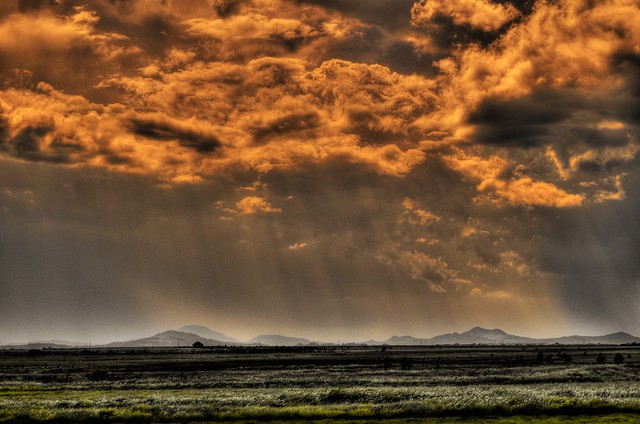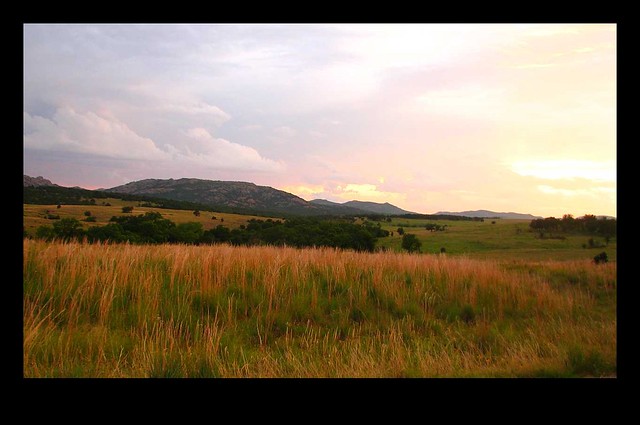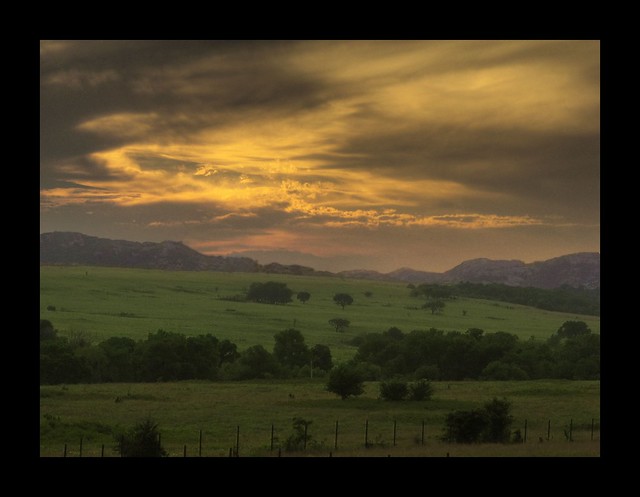.
Every night, all through the land rush, haunted by the same dream
Through the sleeping mountains, as the first homesteaders passed
On a frosty morning, when a child had been taken ill
And a cloth had been thrown over the back
Of the wagon -- but whether that cloth was white
Or black none could recall

Bunch, Oklahoma (unincorporated area): photo by Starwalker, 2006

Storm over Snyder, Oklahoma: photo by Jonathan Wheeler, 2010

W.S. Kelly General Store, Cogar, Oklahoma: photo by Tilden, 2006

Storm Over Elk Mountain, Wichita Mountains, Oklahoma (Sunset Peak in distance, Big Four Mountain to the right): photo by Jonathan Wheeler, 2008

Angry Sky Over Big Four Mountain And Sunset Peak, Wichita Mountains Wildlife Refuge, Oklahoma: photo by Jonathan Wheeler, 2009


By the by, for what it's worth dept.: when I wobbled into the boiler room beneath the ark of the blogger covenant in order to put this one up, a notice alerted me it is the 1000th post on this blog.
ReplyDeleteSo now I guess I know where all that missed sleep went.
Tom,
ReplyDeletebeautiful photos to complement very strong lines...and it may be a strange thing to say but the photos look very natural....it is hard to imagine that these parts were barren and infertile as a dry old woman...
Tom,
ReplyDeleteGood to see that the land remains after the Land Rush (at least some of it) -- "sleeping mountains," hundreds of grasses. . . . OK is a place I've never been, my father grew up in Tulsa, so these latest dispatches are especially appreciated. . . .
1.16
grey whiteness of fog against invisible
ridge, shadowed green black pine branch
in foreground, sound of wave in channel
parallel place, will appear
at point which may be
experience, observable fact
follows, body at rest
silver of sunlight reflected in channel,
shadowed green slope of ridge across it
T & A ~
ReplyDeleteCongratulations on the 1000 Arabian Nights (BTP)! We've been with you much of the way.
Now, how are the kit-cats feeling?
all's well, Bob & Susan
runestones in Heavener Oklahoma
ReplyDeletenot far from Poteau/the furthest
inland the Vikings
Manik, Steve, Bob, many thanks.
ReplyDeleteBob, the kit-cats are getting back into gear, currently, which is better than I am able to say for my own lame ancient self, as of that hard encounter with pavement last month... if only, the thought occurs, one had the ability of a feline to fall with (rather than simply, forever, from) grace.
And yes, Steve, who knows what or who is buried under these grasses...
Elmo, this is your neck of the woods, so I'm sure you've clamped your glims upon that Heavener Runestone, Poteau Mountain, Oklahoma.
(As you've noted, that's the vicinity pictured in the top photo, here.)
A bit of scratching round revealed that, as is their wont, the experts can't agree on whether the Heavener stone inscriptions were or were not actually made by Vikings:
"Author Gloria Farley is among those who attribute the inscription to wandering pre-Columbian Norsemen. However, the inscription has been rejected by Scandinavian philologists and runologists, who consider it most likely modern (19th or early 20th century). The reading of the 'Elder Futhark' style runes would probably be 'GNOMEDAL' (meaning 'Gnome Valley', or perhaps a personal name 'G. Nomedal').
"The difficulty of using the Heavener Runestone to demonstrate Viking exploration of the area is that the Elder Futhark had become obsolete by the 8th century, long before the Viking expeditions to Greenland and Vinland. Also, only six of the eight characters are correct Elder Futhark runes. A transliteration would read "G [rough backwards N] O M E D A [backwards L]".
"In 1967 Alf Monge speculated that the letters represent an elaborate cryptogram, using three runic alphabets, that decodes to 'November 11, 1012'.
"Amateur researcher Richard Nielsen proposed that a Viking explorer hastily reversed the last letter and substituted a letter from the then-extinct Gothic alphabet in the second position. According to this interpretation, the inscription reads 'GLOME DAL' -- the 'Valley of Glome'. Unfortunately, this explanation would require the Norse explorer to have known two extinct alphabets.
"Two other, much smaller inscribed stones have been found near Heavener. In the 1970s scholars translated these stones.
"Heavener stone #2 is said to show the letter 'R' and a 'bind rune". This would be in the Anglo-Saxon character set since in the Norwegian this might be an 'M' and a small cross. In the Elder Futhark, this could be an 'R'/'Z' or a 'T'. It has also been given as '25 December, 1015' in Monge's 'Norse Code' date system.
"Heavener stone #3 is said to show the letters 'G', 'R' and 'T'. This could be in the Anglo-Saxon character set since in the Norwegian set this might be an 'M', a 'T' and the small cross COULD be an 'N". In Monge's system (which seems to be applicable to any group of runes) this gives the date '30 December, 1022'."
"Several other inscribed stones have been found in Oklahoma, one near Poteau, one in Shawnee, and one in Turley north of Tulsa. In fact, the Tulsa area is alleged to have 4 runestones along the Arkansas River on Turkey Mountain, all with very similar characters. One was destroyed in the 1960s, and the specific locations of two others are not known."
All one can safely say, finally, it seems, is that it's better to have a Gnomedal or even a Glomedal than no medal at all.
(And just on general principles, one has to hand it to those Vikings for their ability to get around, whether they made these inscriptions or not.)
Seeing this much of America that is new to me (it's as amazing what you don't see out of an airplane window as what you do; the closest I've been to Oklahoma is seeing road signs to Tulsa in Little Rock) through the contemporary photos and the new poem about old events is very moving. Congratulations on 1,000.
ReplyDeleteIf you look closely at my photo (I'm starwalker) of Bunch, Oklahoma, you will see a train headed north on the Kansas Cith Southern. The lead engines are at the lower right just on the other side of the road, and you can see the coal cars in the distance as they go through Bunch. This picture, by the way, is from our pasture.
ReplyDeleteThat's a beautiful photo, Darrel. And that's a very well camouflaged train. Thanks very much for the picture -- and for helping me to see it better.
ReplyDelete